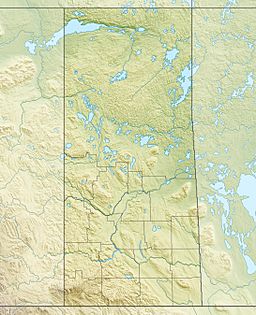Besnard Lake facts for kids
Quick facts for kids Besnard Lake |
|
|---|---|
| Location | Saskatchewan, Canada |
| Coordinates | 55°25′00″N 106°00′02″W / 55.4167°N 106.0005°W |
| Type | lake |
| Max. length | 43 km (27 mi) |
| Surface area | 12,500 hectares (31,000 acres) |
| Max. depth | 25 metres (82 ft) |
| Shore length1 | 400 km (250 mi) |
| Surface elevation | 390 m (1,280 ft) |
| 1 Shore length is not a well-defined measure. | |
Besnard Lake ( BEZ-nerd) is a lake in the Canadian province of Saskatchewan. It is about 370 kilometers north of Saskatoon. The lake is also 50 kilometers west of La Ronge. Besnard Lake is home to many bald eagles. Scientists have been studying these eagles since the 1960s.
The lake is quite long, measuring 43 kilometers from end to end. It has a very long shoreline, about 400 kilometers. The total area of the lake is 12,500 hectares. At its deepest point, the lake is 25 meters deep. The lake sits at an elevation of about 390 meters above sea level.
A bridge crosses the lake at a narrow spot. This bridge carries Provincial Highway 910. The road was finished in 1973. It made it easier for people to visit the lake for fishing and fun.
Besnard Lake has more than 250 islands. The bottom of the lake is rocky. This makes it a bit tricky to navigate boats. However, the rocky bottom is a great place for fish to live. You can find cabins, campgrounds, and fishing camps around the lake. There is also a 950-meter airstrip about 1 kilometer south of the lake.
Besnard Lake is part of the Churchill River water system. Much of the lake is in the Canadian Shield area. This is a large region of ancient rock. The southern part of the lake is in the boreal forest. Here, the Mercer River flows into the lake. This river brings nutrients that help small water creatures grow. These creatures are food for fish, which are the main diet for the eagles.
Eagles at Besnard Lake mostly eat white sucker and cisco fish. Sometimes, they also catch pike, walleye, and burbot. Compared to nearby Nemeiben Lake, Besnard Lake has more eagles. It also has a more stable eagle population. Nemeiben Lake is entirely within the Canadian Shield.
Studying Besnard Lake's Eagles
The bald eagle population at Besnard Lake has been studied for over 50 years. This long study began when Jon Gerrard discovered the eagles there. Scientists have learned a lot about how eagles live and behave. They have studied how eagle populations change, how they grow, and where they migrate.
More than 50 scientific papers have been published from these studies. A book called The Bald Eagle: Haunts and Habits of a Wilderness Monarch was also written in 1988. Over 800 eagles have been banded (given a small tag on their leg). These banded eagles have been found to spend their winters in places like Iowa, Missouri, Wyoming, and Montana. Some have even been found as far south as Texas, Arizona, and Southern California.
In the 1960s, many people thought bald eagles were rare in Canada. They were mostly seen near the Atlantic and Pacific coasts. In 1966, Jon Gerrard found 18 eagle nests with 27 young eagles in the Besnard Lake area. A bigger survey in 1974 found 14,000 eagles in the region. Besnard Lake turned out to be a perfect place to study bald eagles in their boreal breeding grounds. Since the 1970s, the lake has supported a steady population of about 100 eagles.
One interesting discovery was how to tell the sex of young eagles. Scientists found they could accurately tell if an eagle was male or female. They did this by measuring the size of its foot and the length of its culmen (the top part of its beak). This led to another discovery: the amount of food available seems to affect the sex of the young eagles. More females hatch when there is plenty of food. Female eagles are larger than males. On other lakes where food is not as plentiful, more male eagles tend to hatch.


